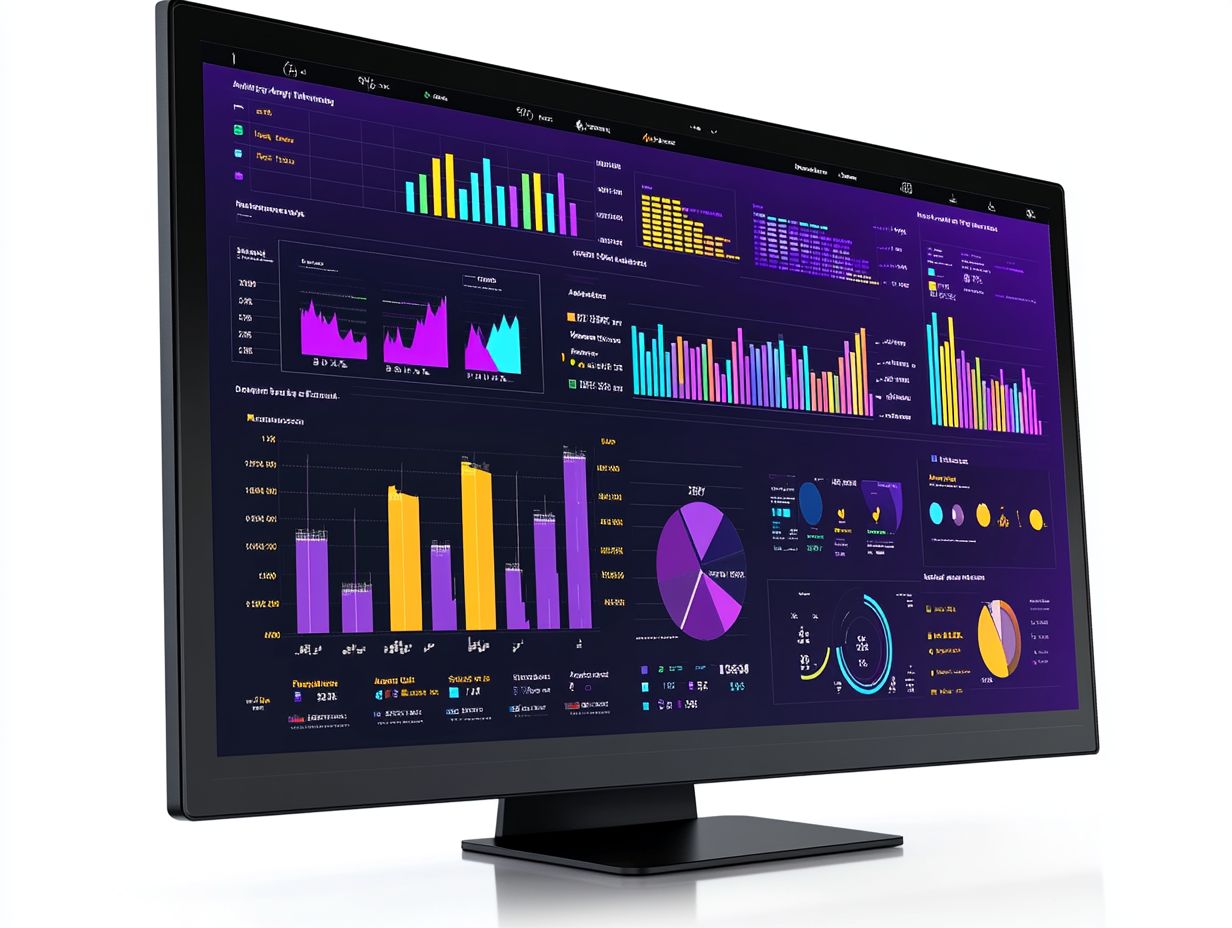Key Metrics to Monitor in Hybrid Cloud
Hybrid cloud environments are increasingly becoming the go-to choice for organizations like yours that seek flexibility and scalability in their IT infrastructure.
To effectively manage these intricate systems, you need to grasp key performance metrics that truly matter. This article dives into the essential metrics you should monitor think network performance, storage capacity, application availability, and cost management that can significantly shape your hybrid cloud strategy.
You’ll also discover the tools and techniques available for monitoring. Additionally, we present best practices designed to ensure optimal performance and foster collaboration with cloud providers.
Whether you’re just beginning your journey, or aiming to refine your current setup, this guide equips you with the insights necessary to thrive in a hybrid cloud landscape.
Contents
- Key Takeaways:
- Key Metrics to Monitor in Hybrid Cloud
- Storage Capacity and Utilization
- Application Availability and Response Time
- Cost Management and Optimization
- Tools and Techniques for Monitoring
- Best Practices for Monitoring Hybrid Cloud
- Frequently Asked Questions
- What are the key metrics to monitor in hybrid cloud?
- Why is it important to monitor these metrics in a hybrid cloud environment?
- How can resource utilization be measured in a hybrid cloud?
- What is the recommended approach for monitoring performance in a hybrid cloud?
- How can security be monitored in a hybrid cloud environment?
- How can organizations track and manage costs in a hybrid cloud?
Key Takeaways:

Properly monitoring network performance is crucial in maintaining the stability and efficiency of a hybrid cloud environment.
Keeping track of storage capacity and utilization is essential to ensure efficient resource allocation and cost management.
Regularly monitoring application availability and response time is key to delivering a seamless user experience.
Defining Hybrid Cloud and its Benefits
Hybrid cloud is an innovative IT infrastructure model that seamlessly blends public and private cloud environments, enabling you to harness the strengths of both while retaining control over your sensitive data.
This approach provides you with unmatched flexibility and scalability. It allows you to optimize cloud operations and customize your strategies to align with your specific needs.
By incorporating cloud performance measurements such as uptime availability and operational efficiency, you can gain valuable insights into resource utilization.
This paves the way for a more agile and cost-effective IT framework. Major providers like AWS, Microsoft Azure, and Google Cloud enhance resource optimization, enabling you to allocate workloads effectively based on demand.
For example, you can house critical workloads in private clouds for that extra layer of security. Meanwhile, less sensitive tasks can reap the cost benefits of public cloud resources.
This dual approach not only minimizes risks but also opens up exciting opportunities for scaling during peak periods or rapid growth. You can ensure that you operate within budget while successfully achieving your strategic objectives.
Key Metrics to Monitor in Hybrid Cloud
In the dynamic realm of hybrid cloud solutions, keeping a close eye on key metrics, such as those outlined in the performance metrics of leading cloud providers, is vital. These metrics profoundly influence performance, efficiency, and cost management.
Focusing on various performance metrics like CPU utilization, memory utilization, and error rates will help you ensure optimal uptime and service reliability.
Tracking cost metrics is also essential. This includes the cost per feature and cost per customer, which enables you to align your cloud operations with business objectives effectively.
Network Performance
Network performance plays a crucial role in hybrid cloud monitoring. It greatly impacts the efficiency of your cloud operations and the overall user experience.
High network capacity and minimal packet loss are vital for ensuring that data transfers seamlessly and applications respond promptly, especially in environments where data is exchanged between public and private clouds.
Prioritizing network performance metrics allows you to proactively identify and address potential bottlenecks. This enhances your operational resilience.
Monitoring solutions such as SolarWinds, Nagios, or Dynatrace offer real-time insights into bandwidth usage and highlight areas prone to latency. Implementing strategies like quality of service (QoS) configurations allows you to prioritize critical application traffic.
Regular assessments and optimizations not only elevate performance but also boost productivity. This is particularly important for businesses relying on real-time data access and cloud-based applications.
Ultimately, concentrating on effective network performance enhances the reliability and speed of your hybrid cloud services. This lays a robust foundation for future growth.
To stay ahead of issues, start monitoring your network performance today!
Consider implementing the tools and practices discussed here to enhance your hybrid cloud strategy.
Storage Capacity and Utilization
Managing storage well is essential for keeping your hybrid cloud running smoothly. Monitor these metrics to align your storage with your operational needs.
High memory use can indicate strain on resources. Conversely, low storage use may suggest a need to rethink your data management approach.
Implementing best practices like regular performance assessments, automated scaling, and analytics tools can boost your efficiency.
By tracking usage trends and spotting patterns, you can adjust your storage allocations proactively. This approach helps reduce risks of data loss and performance issues while supporting cost management.
Ultimately, good storage management enhances agility and responsiveness, enabling you to adapt to changing market demands and technology.
Application Availability and Response Time

Application availability and response time are key metrics that impact user satisfaction and your business’s smooth operation in a hybrid cloud environment.
You must ensure high uptime to manage increasing requests while keeping repair times low during outages. Focusing on application resilience improves user experience and boosts efficiency.
Implement strong monitoring tools for real-time insights into these metrics. Use tools that check how well your applications are running and alert you to issues quickly.
Load balancing, auto-scaling, and regular performance audits can significantly enhance uptime and response times.
Striking the right balance between these factors not only boosts your applications’ availability but also builds customer trust and loyalty vital for growth in today s competitive landscape.
Cost Management and Optimization
Cost management is vital to your hybrid cloud initiatives. It helps maximize value while keeping costs in check. By analyzing metrics like cost per feature and cost per customer, you can identify inefficiencies.
This proactive approach aids budgeting and aligns your cloud operations with your broader business goals.
In hybrid cloud environments, managing costs becomes more important due to complexity and fluctuating resource usage. To monitor expenses effectively, use tools that provide real-time insights.
Techniques like tagging resources and automated scaling policies improve your visibility into usage patterns, enabling strategic adjustments.
Establishing a governance framework ensures accountability for costs, promoting a culture of efficiency that enhances performance and service quality.
Tools and Techniques for Monitoring
To effectively monitor hybrid cloud environments, leverage a variety of tools and techniques that provide valuable insights into your operations.
Consider using cloud monitoring platforms like Datadog, Splunk, and SolarWinds for robust performance tracking.
Automation monitoring tools can streamline processes and improve operational efficiency.
Data analytics is crucial. It helps you understand the metrics collected and allows for proactive management.
Cloud Monitoring Platforms
Cloud monitoring platforms have become essential for organizations navigating hybrid cloud environments. They offer a comprehensive view of cloud metrics and performance.
Solutions from industry giants like AWS, Microsoft Azure, and Google Cloud are tailored to monitor various aspects of your cloud operations. This allows you to maintain uptime and optimize resource utilization.
These platforms provide a centralized approach to tracking performance metrics. This ensures you can respond swiftly to any emerging issues.
Beyond basic monitoring capabilities, these tools include advanced features such as automated alerts and tools that help you anticipate and prevent problems. This helps you stay ahead of potential disruptions.
They work seamlessly with your existing cloud services, providing real-time insights into metrics like CPU usage, memory allocation, and network latency.
By enabling you to visualize data trends and operational bottlenecks, hybrid cloud monitoring solutions significantly enhance your decision-making process.
The ease of configuration and extensive reporting options empower your teams to fine-tune their cloud strategies. Ultimately, this leads to improved efficiency and cost savings.
Automation and Alerting
Automation and alerting systems are essential elements of effective hybrid cloud monitoring. They enable you to streamline operations and respond swiftly to potential issues.
By implementing automation monitoring solutions, you can optimize your cloud operations. This significantly reduces the risk of human error while ensuring consistent performance across your infrastructure.
Alerting systems are pivotal in this process, delivering real-time notifications about performance metrics, security metrics, and other critical data points.
Leveraging tools such as AWS CloudWatch, Azure Monitor, or even open-source options like Prometheus establishes a robust framework for monitoring your systems. These tools not only automate data collection and analysis but also enable customizable alerts that notify your team of anomalies before they develop into major problems.
This proactive approach enhances operational efficiency and minimizes downtime. It ultimately cultivates a more resilient hybrid cloud environment. With this approach, you and your team can concentrate on strategic initiatives instead of getting tangled up in reactive troubleshooting.
Data Analytics and Reporting

Data analytics and reporting are crucial for converting raw cloud metrics into actionable insights. This enhances operational efficiency within hybrid cloud environments.
By utilizing advanced analytics tools, you can uncover trends and patterns in performance metrics. This enables you to make informed decisions about resource allocation and optimization.
Robust reporting capabilities ensure that you and your stakeholders remain well-informed about cloud operations and security metrics while adhering to best practices.
In this setting, leveraging approaches like predictive analytics allows you to foresee potential issues before they escalate. This enables you to implement proactive measures.
Tools such as Splunk, Tableau, and Azure Monitor provide visualizations that simplify complex data sets. This makes insights more accessible, even for non-technical users.
Incorporating machine learning algorithms can significantly enhance anomaly detection, offering early warnings about security vulnerabilities.
By integrating these analytical capabilities, you can improve performance and strengthen your security posture. This ensures alignment with regulatory requirements and industry standards for compliance.
Best Practices for Monitoring Hybrid Cloud
Implementing best practices is crucial for effectively monitoring hybrid cloud environments. This allows your organization to uphold optimal performance and security.
Proactive monitoring strategies are vital in identifying potential issues before they escalate. This ensures you stay ahead of any disruptions.
Collaborating closely with cloud providers enhances communication and alignment on your operational goals.
Integrating automated monitoring into your workflow elevates resource management and operational efficiency. This streamlines processes and minimizes manual oversight.
Proactive Monitoring and Maintenance
Proactive monitoring and maintenance are essential for ensuring the seamless operation of your hybrid cloud environments. This approach minimizes downtime and enhances overall performance.
By adopting a proactive stance, you can identify potential issues early, allowing for corrective actions to be taken before they disrupt your operations. Consistently tracking performance metrics helps maintain optimal cloud operations and deliver a flawless user experience.
This practice is particularly crucial in today s fast-paced technological landscape, where multiple cloud platforms and on-premises systems interconnect seamlessly.
Implementing advanced tools, like Application Performance Monitoring (APM), helps track how well your applications are running. Infrastructure Monitoring can significantly support your efforts by offering real-time insights into resource utilization and system health.
By utilizing automated alerts, your teams can swiftly respond to any anomalies, further strengthening your resilience.
With the right blend of techniques and tools, you can navigate potential disruptions effortlessly, ensuring both reliability and efficiency across your hybrid cloud environments.
Collaboration and Communication with Cloud Providers
Collaboration and communication with your cloud providers are vital for successful hybrid cloud monitoring. This ensures that your operational strategies align seamlessly with their service capabilities.
Establishing effective communication channels allows you to swiftly address any issues that arise. Fostering a collaborative environment enhances problem-solving and sparks innovation, ultimately translating to improved performance metrics and greater user satisfaction.
Regular check-ins and updates create a culture of transparency, enabling you to adapt effortlessly to any changes that may impact operations. Participating in joint workshops and strategy sessions can provide invaluable opportunities to share insights and refine processes.
A pivotal strategy involves outlining clear service-level agreements (SLAs) that define performance expectations and responsibilities. This ensures that both you and your providers remain aligned. By utilizing monitoring tools that correspond with these SLAs, you can facilitate proactive responses to potential disruptions, significantly enhancing service reliability and performance.
Frequently Asked Questions
What are the key metrics to monitor in hybrid cloud?

The key metrics to monitor in a hybrid cloud include resource utilization, performance, availability, security, cost, and user experience.
Why is it important to monitor these metrics in a hybrid cloud environment?
Monitoring these key metrics allows organizations to identify potential issues and make necessary adjustments to optimize the performance and efficiency of their hybrid cloud environment.
How can resource utilization be measured in a hybrid cloud?
Resource utilization can be measured by monitoring the usage of CPU, memory, storage, and network resources across both on-premises and cloud environments.
What is the recommended approach for monitoring performance in a hybrid cloud?
The recommended approach for monitoring performance in a hybrid cloud is to use a combination of real-time monitoring tools and proactive testing. This ensures consistent and reliable performance for end-users.
How can security be monitored in a hybrid cloud environment?
Security in a hybrid cloud environment can be monitored by tracking and analyzing network traffic, implementing access controls, and regularly auditing the security of both on-premises and cloud resources.
How can organizations track and manage costs in a hybrid cloud?
To track and manage costs in a hybrid cloud, organizations should regularly review usage and spending data, set budget limits, and utilize cost management tools offered by cloud service providers.
Ready to enhance your cloud strategies? Act now and reach out for more information on implementing proactive monitoring!






